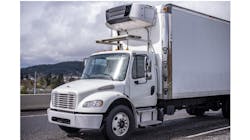Modern TRU innovations build on cold chain's zero-emissions legacy
During my career as a truck technician, I became fascinated with not only the refrigeration cycle of heat removal, but also the ability of units to maintain temperatures of -20 degrees F for frozen products and up to 80 degrees F for heated ones. Temperature control is now used in many aspects of our lives, from ice cream delivery to ripening bananas, or temporary storage at morgues to life-saving medicines that need precise temperature control as they are transported. This ability to maintain a wide range of temperatures—from freezing to hot—gives trucking companies a greater ability haul a variety of items.
And the process of innovating ways to control temperature to keep our food supply safe has been developed over thousands of years ago, dating back thousands of years. While researching information for this article, I found that our ancestors carved out blocks of ice to cool and preserve their food stores. Some, such as the Chinese during the Bronze Age, even learned to make and preserve ice cream. That revelation conjures up images of an ancient cold chain—carts, wagons, and boats all filled with food in crude coolers. Fast forward thousands of years to the early 1800s, and railroad boxcars began utilizing this age-old process of artificial cooling as well, but with a new name: “refrigeration.” Electric fridges were then developed for homes and then for transport (powered by fossil fuel engines) in the 1900s. Now modern logistics companies can employ high-tech zero-emission transportation refrigeration units (TRUs), with connected temperature senors that can issue real-time alert to any problems with the system. We've come along way from chiseled ice.
However, transport refrigeration may change when the trucks carrying these loads become zero-emission vehicles (ZEVs). And the question remains whether ZEVs can handle the demands of maintaining such extreme temperatures. This change is coming soon, considering recent developments in the transport refrigeration space:
- At the May 2023 Brisbane Truck Show, Carrier Transicold unveiled its engineless Carrier Transicold Vector HE19 and Vector 1550, which utilizes the company’s E-Drive all-electric technology with advanced energy recovery and storage systems. This system captures kinetic energy through generators mounted on the trailer axles and stores it in battery packs to power the refrigeration system. The result is that products can be transported and temperature controlled using ZEV technology.
- Thermo King’s e1000 All-Electric Reefer Unit for Classes 5 through 7 vehicles will be available to order in 2023. Besides providing TRUs for trucks and trailers, both Thermo King and Carrier Transicold provide electric refrigeration for marine, air, and rail applications not only in North America, but many other regions around the world.
- In January 2023, three companies in the Netherlands came together for a 12-month pilot program designed to capture energy lost at the wheels and use it as a power source for the refrigeration unit. With a partnership between service provider TIP Group, Thermo King, and gear system manufacturer BPW Bergische Achsen KG, the trailers will be operated for Albert Heijn, which is the largest supermarket chain in the Netherlands.
From massive super freezers with range capacities from -94 degrees F to 122 degrees F to electrically refrigerated tricycles, our world survives through food, product preservation, and technological innovation.
This makes it interesting to see how both ancient ZEVs and refrigeration have developed alongside each other to become today’s new zero-emission refrigerated vehicles. Just as ice blocks and carts have led to electric TRUs, perhaps all the time in between was the precursor of the “Messy Middle,” and the industry can look forward to similarly positive results.
Ed Chipalowsky is vehicle service and support manager for the North American Council for Freight Efficiency (NACFE). In this role he will be reaching out to OEMs, fleets, vendors, and municipalities to learn about their challenges in not only developing curriculum for EV technicians but also how to recruit and develop future EV techs.
About the Author
Ed Chipalowsky
vehicle service and support manager, North American Council for Freight Efficiency
Ed Chipalowsky is vehicle service and support manager for the North American Council for Freight Efficiency (NACFE). In this role he will be reaching out to OEMs, fleets, vendors, and municipalities to learn about their challenges in not only developing curriculum for EV technicians but also how to recruit and develop future EV techs. Chipalowsky has an extensive background in trucking and education. He has more than 40 years’ experience as a technician manager and trainer including serving as a diesel technology instructor in both college and career and technical education high schools.
